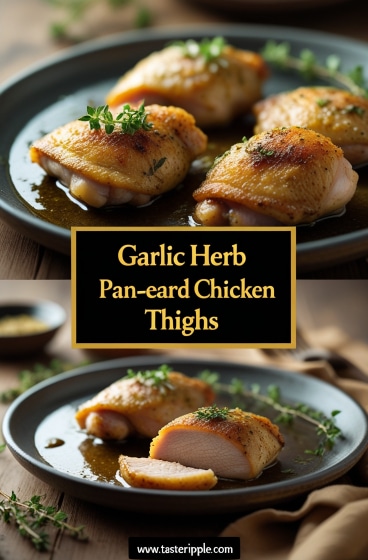I’ll tell you something—when I first started cooking professionally, I avoided chicken thighs. I thought, like many young cooks, that chicken breast was the “better” cut. Leaner, faster, more versatile, so they said. But then I discovered that thighs hold the kind of flavor that lingers on the tongue, the kind of juiciness that refuses to dry out even if you treat them a bit rough. Once you cook with thighs, you don’t go back so easily.
There’s something humble yet powerful about this cut. Bone-in or boneless, skin-on or skinless, each form has its own charm. Chefs love thighs because they forgive mistakes. Home cooks love them because they cost less but taste richer. And diners, well, they rarely know why a chicken dish is so good, but odds are—thighs are involved.
In this piece, we’ll go deep. We’ll explore the techniques, the science, the practical tips, and the little quirks of cooking with chicken thighs. By the end, you’ll see why thighs are the unsung hero of the poultry world and how you can turn them into a centerpiece of dishes that shine in any kitchen.
Why Chicken Thighs Are Special
Chicken thighs bring a buttery richness that breasts just can’t match. They have more connective tissue and fat, which means flavor. That same fat renders slowly during cooking, keeping the meat moist even after high heat. This is why thighs can be roasted, braised, grilled, or fried without fear.
Another reason they’re prized is versatility. Asian stir-fry? Use boneless thighs. Slow-cooked Moroccan tagine? Bone-in thighs hold up beautifully. Quick weeknight sheet pan dinner? Skin-on thighs crisp like no other. They adapt to spice rubs, marinades, sauces, and cooking styles from almost every cuisine on the globe.
Culturally, thighs have been beloved long before Western kitchens rediscovered them. In Japanese yakitori, thigh meat (momo) is skewered and grilled over charcoal for smoky bites. In Indian curries, thighs simmer in spiced gravies, soaking in flavor while keeping tender. Even in French country cooking, thighs are the star in coq au vin.
Ingredients & Substitutions
To really showcase chicken thighs, let’s work with a recipe that balances crispness, succulence, and depth of flavor: Pan-Seared Garlic Herb Chicken Thighs. Below is a full ingredient list with notes on substitutions.
Ingredient Table
| Ingredient | Measurement | Notes & Substitutions |
|---|---|---|
| Chicken thighs (bone-in, skin-on) | 6 pieces | Boneless thighs work too, reduce cook time by 5–7 mins |
| Olive oil | 2 tbsp | Substitute avocado oil or canola oil for high-heat cooking |
| Garlic cloves (minced) | 4 large | Garlic powder in a pinch, but fresh gives better bite |
| Fresh thyme leaves | 2 tsp | Swap with rosemary, oregano, or dried herbs (1 tsp dried) |
| Paprika | 1 tsp | Smoked paprika adds deeper flavor |
| Salt | 1 ½ tsp | Kosher salt recommended for even seasoning |
| Black pepper (freshly cracked) | 1 tsp | White pepper if you want less sharpness |
| Lemon juice | 2 tbsp | Can use white wine vinegar if lemons aren’t on hand |
| Unsalted butter | 2 tbsp | For richness; omit if dairy-free |
| Chicken stock | ½ cup | Vegetable stock or water if needed |
| Parsley (chopped) | 2 tbsp | Cilantro for a fresh twist |
A few ingredient notes: using fresh herbs makes a bigger difference than most think. Fresh thyme releases oils that perfume the entire pan, while dried herbs give more muted tones. Bone-in thighs not only cook juicier but the bones themselves deepen flavor in the pan sauce. If you’re tempted to swap butter with margarine, don’t—it simply won’t carry the same nutty depth when browned.
Step-by-Step Instructions
Step 1: Prepare the Thighs
Pat the thighs dry with paper towels. This is not optional—moisture on the surface prevents browning and encourages steaming. One mistake many cooks make is seasoning wet chicken; the salt slides off, flavor is lost.
Step 2: Season Generously
Rub thighs with salt, pepper, paprika, and thyme. Don’t be shy. Chicken thighs can handle heavier seasoning because of their fat content. Under-seasoned thighs taste flat, and no sauce can completely fix it later.
Step 3: Heat and Sear
Heat olive oil in a heavy skillet (cast iron ideal) over medium-high. Place thighs skin-side down. Do not move them for at least 6–7 minutes. The skin needs contact to crisp. Common mistake: flipping too early. If the skin sticks, it’s not ready yet.
Step 4: Add Garlic and Butter
Once thighs are golden brown, flip them. Add minced garlic and butter. Tilt pan, spoon melted butter over the chicken. This baste builds layers of flavor and keeps skin glossy. Be careful not to burn garlic—it turns bitter fast.
Step 5: Deglaze
Pour in chicken stock and lemon juice. Scrape bottom of pan with a wooden spoon to loosen browned bits. This creates the sauce base. Avoid metal spatulas in cast iron; they scrape seasoning.
Step 6: Simmer and Finish
Reduce heat to medium-low. Cover partially and let cook 20–25 minutes until internal temp hits 175°F. Unlike breast, thighs shine when cooked beyond the safe 165°F mark. At 175°F–185°F, collagen melts, making meat fall-off-the-bone tender.
Step 7: Garnish and Serve
Sprinkle parsley over the top. The fresh herb cuts through richness, balancing the dish. Serve with sauce spooned over each piece.
Variations
- For spice lovers: add 1 tsp cayenne with paprika.
- For creaminess: stir ¼ cup heavy cream into sauce at the end.
- For Mediterranean twist: add olives and sun-dried tomatoes before simmering.
Cooking Techniques & Science
Why does searing matter? When thighs hit hot oil, proteins and sugars on the surface undergo Maillard reaction. That golden crust isn’t just for looks—it delivers deep roasted flavor.
Why cook thighs to 175°F instead of 165°F? Because of collagen. Thighs are loaded with connective tissue. At 165°F, they’re safe but chewy. Keep going, and collagen melts into gelatin, creating juicy, tender bites. That’s why braises taste so silky.
Why bone-in skin-on? Skin crisps and protects meat from drying. The bone conducts heat slowly, preventing overcooking. Boneless thighs are faster but less forgiving.
Storage & Reheating
Store cooled thighs in airtight containers up to 4 days. For reheating, avoid microwaving if possible—it makes skin soggy. Best method is oven: 350°F for 15 minutes covered with foil. If you must microwave, place a damp paper towel on top to keep moisture.
Tools that Matter
- Cast iron skillet: retains heat, ensures crisp skin.
- Instant-read thermometer: takes guesswork out.
- Tongs: safer and cleaner than forks when flipping.
Variations & Substitutions
- Gluten-free: no adjustments needed, this dish is naturally gluten-free.
- Dairy-free: skip butter, use extra olive oil.
- Vegan: substitute chicken thighs with seitan or mushrooms, but keep same pan sauce method.
Serving & Pairing Suggestions
This dish loves company. Serve over buttery mashed potatoes, which soak up the pan sauce beautifully. Or try with rice pilaf, letting the grains carry garlic-herb flavors.
A crisp green salad balances richness. Bitter greens like arugula work well. For bread lovers, a crusty baguette is perfect for mopping sauce.
Wine pairing? A medium-bodied Chardonnay, slightly oaked, enhances lemon-butter notes. Beer drinker? Go Belgian blonde ale—it’s malty but light enough not to overpower.
For plating, don’t hide the skin. Place thighs skin-side up so diners see the crisp golden crust. A quick drizzle of sauce around the edge of the plate feels restaurant-worthy without fuss.
Best Time to Serve
This recipe fits many occasions. Weeknights? Absolutely, since active cooking is just 15 minutes. Dinner parties? Perfect, because thighs stay juicy even if guests arrive late.
Cold weather amplifies the comfort factor—rich sauce, warm skillet, savory aromas. But in summer, pair with grilled vegetables and a chilled white wine, and it feels bright instead of heavy.
Conclusion
Chicken thighs are the cut every cook should master. They’re affordable, forgiving, and endlessly versatile. By learning how to season boldly, sear properly, and cook past the usual temperature, you unlock their true potential.
The recipe we covered—Garlic Herb Pan-Seared Thighs—is just one doorway into countless variations. Once you understand the technique, you can switch spices, swap sauces, and create dishes spanning continents.
If there’s one tip to remember, it’s this: don’t rush. Let the skin crisp, let the sauce reduce, let the collagen melt. Time is the secret ingredient that turns thighs from good to extraordinary.
FAQs
Can I make this recipe ahead of time?
Yes. Cook thighs fully, cool, and refrigerate up to 2 days. Reheat gently in oven with foil. Sauce can be made fresh when reheating for best flavor.
How do I know when thighs are done without a thermometer?
Pierce the thickest part with a knife. If juices run clear and meat pulls easily from bone, they’re done. Still, a thermometer is more reliable.
Should I remove the skin for lower fat?
You can, but you’ll lose crispness and some moisture. A trick is to cook skin-on, then remove skin before serving if you want leaner meat but crave that richness in cooking.
Can I grill this instead of pan-searing?
Absolutely. Marinate with the same seasoning, grill skin-side down first, then flip. Cook over indirect heat until internal temp reaches 175°F.
Why does my garlic burn sometimes?
Garlic burns quickly in hot oil. Add it only after flipping thighs, when pan temperature drops slightly. Keep it moving in the butter so it browns gently instead of scorching.

